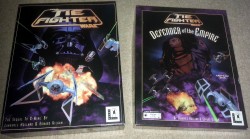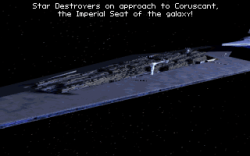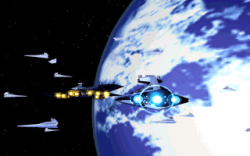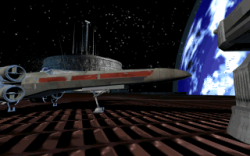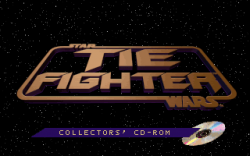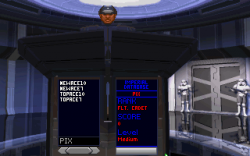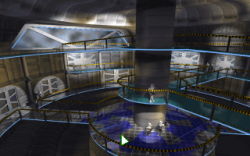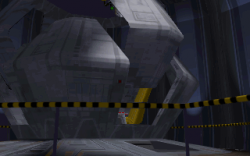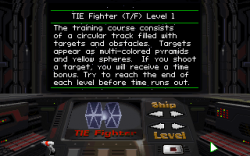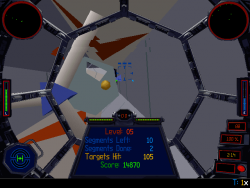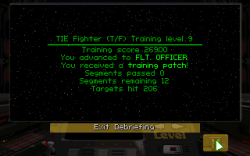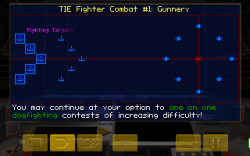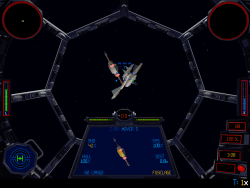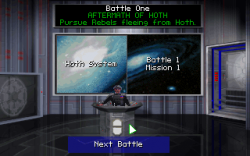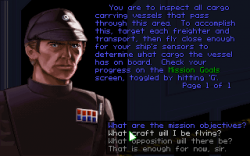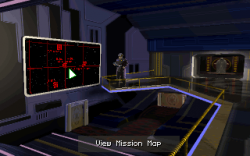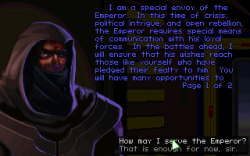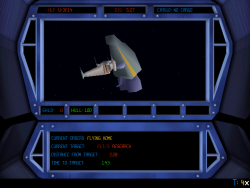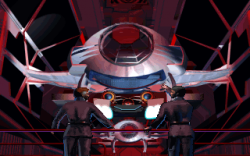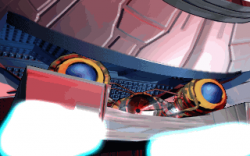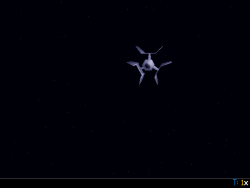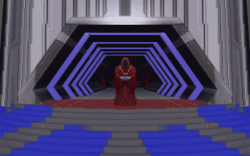After a week of board games, I’m moving back onto the home territory that is DOS gaming with a brief playthrough of Lucasarts classic space sim Tie Fighter which has just celebrated its 20th anniversary. It’s not an Origin game but I’ve already played through X-Wing on this blog so I don’t see why I can’t add Tie Fighter onto the list as well. I will keep it relatively brief though and just concentrate on the differences between the games.
The success of X-Wing had clearly started the Star Wars ball rolling with Lucasarts who released the first Rebel Assault game in 1993 and would release Dark Forces in 1995. In the year between X-Wing got its long awaited sequel in the shape of Tie Fighter where the player would now get to fly for the emperor.
This is one of the titles in the collection that I bought at the time which is usually evident by the poor condition and indeed some of the manuals are a little grubby but the box at least has held up well. Anyone who bought X-Wing would feel instantly at home with the same collection of manuals in near identical formats. These include a large paperback called The Steele Chronicles telling the backstory of the pilot you play in the game. This story would be continued in the strategy guides which are available in the downloads on this site.
Tie Fighter only got the one expansion pack of which I have the US release. There was also a later rerelease on CD-ROM with this expansion pack, the original game and several other extra campaigns included which is the version I’ll be playing. This version added speech to the game and most importantly an SVGA mode for flight offering a huge improvement in the graphics for those with a PC up to the task.
Another difference on the CD-ROM version is the introductory cutscenes which are for the most part streamed off the CD in considerably more style than those on the floppy disk release. After the introduction, these revert to the regular cutscenes for all other purposes which still look perfectly ok with the same sort of painted art style used in so many Lucasarts adventure games to good effect.
The interface is straight out of X-Wing with all the same options offered from a central hub in the ship. I may as well say from the outset that Tie Fighter didn’t exactly have much in the way of innovation and was very much an iterative improvement on X-Wing offering tweaks throughout but little new. Given that X-Wing is undoubtedly one of my favourite games of all time, this is hardly something that will put me off but I do recall being a little let down back in 1994.
I start in the training simulator. The maze of X-Wing is replaced with a series of tunnels containing targets, fans and rotating plates with small holes to fly through. These levels start out with just a couple of targets, adding complexity with each new level. Complete level 5 in any given ship and you get a training patch. Complete level 8 and you get a promotion but only the first time.
Each level is far shorter than the X-Wing equivalent consisting of only 12 sections to fly through and they are easy enough that it is possible to take advantage of another new feature (time compression) to skip through this part of the game in quadruple-quick time. Compensating for this is a greater variety of ships to complete the course in with the options being TIE fighters, bombers, interceptors, advanced as well as gun boats and the TIE defender. The defender shouldn’t actually be available for training until much later in the game but is here right from the start on the CD-ROM version.
These ships are all quite different to the larger rebel fighters with the basic TIE’s having no shields and only being able to take a few hits. This will strongly affect the gameplay in the early missions of the game. The more advanced ships have shields to manage as well but all have less “characterful” laser positioning than the X-Wing and don’t require the same sort of adjustments when aiming.
The historical missions are less historical this time around and more of a tutorial for the game with introductions to each aspect of controlling your fighter. Another major change is introduced here in the shape of secondary and bonus objectives for each mission with some of the easiest training missions having some ludicrously difficult bonus objectives, e.g. taking on 12 ships at once in an unshielded fighter.
In the actual tour of duty these bonus objectives are hidden until you complete the mission and you can then see them in the historical missions if you want to have a go at completing any you missed. This adds an element of replayability and extra challenge without the off-putting difficulty of X-Wing to the newer player. For the X-Wing veteran however, it has to be said that once into the main campaigns the bonus objectives are usually fairly easy to achieve and this is an easier game at least on the default difficulty setting.
In another new feature the player can ask questions at the briefing both before and after the mission. These are always the same questions but it does allow a little more versatility in the instructions. The major difference is the after mission briefing where tips will be given if you have failed the mission.
Secondary objectives are usually handed out by a shady character hanging out at the back of the briefing room. He belongs to a secret order in service of the Emperor of which the player can rise through the ranks by completing these tasks. Most of them involve scanning ships to gather information. I’d say that in numerous missions you basically have to ignore the primary objective for a period and go off scanning various ships leaving your wingmen to do the job. The fact that the missions have to allow for this is one of the factors making life easier this time around.
During flight the biggest change after the SVGA graphics is the much larger variety of ships in the game. Playing X-Wing, it was quite striking just how small the variety was but here there must be 4 or 5 times as many even if plenty of those are variations on a theme. The TIE Fighter engine is also capable of putting more of these on screen at once leading to some epic battles by comparison.
Another handy new feature is the ‘Z’ key will bring up a display showing all the details about a given ship such as what it’s doing, who it’s attacking, time to target, etc.. This is a huge help when deciding which ships to attack in combat and takes out the trial and error that was required in X-Wing.
The final new feature I’ll mention is a tractor beam weapon which becomes available late into the campaign. These offer an extra system with its own energy requirements to manage and the beam will stop a ship being able to turn when in your sights making it very easy to hit. I’ve mixed feelings about this weapon. It’s arguably most useful simply to switch it off and have the extra energy for other systems but it can have a place against the smaller faster targets.
There are seven tours of duty offered up as opposed to the original three in X-Wing but they are far shorter with just 5-6 missions. The plot is set during the timeframe of The Empire Strikes Back with some references to events in the film but the events in the game are largely original. In the first four of the tours there is barely time for the story to get going before they are over. The later missions follow a continuing plotline involving a coup against the emperor and it’s in these missions that the game really starts as far as I’m concerned.
Given all the improvements I’ve listed this game should eclipse X-Wing but it doesn’t quite do it for me. Part of this is definitely the fact that X-Wing came first which is always hard to overlook if you played it at the time. Another key is the greater atmosphere that was generated in X-Wing due to a combination of reasons.
First off the little cutscenes in X-Wing were more elaborate as you moved between the various sections. There isn’t the Star Wars scrolling text at the start of the campaigns, or the hyperspacing to training grounds. I can see why they were left out to fit the game onto the same number of floppies but it’s still a loss.
Secondly, there isn’t the same tension in this game due to the easier difficulty especially in the earlier missions. In an unshielded ship, Tie Fighter has to take it easy on you for most of the first half of the campaign. With no energy management, the game is simplified and just a little too easy. The time compression makes this worse. Failing at the end of a 30 minute X-Wing mission could make you tear your hair out but it certainly ratcheted up the pressure on the player.
Third the rebel ships are less fun to shoot at. This is because they are for the most part larger slower targets requiring numerous shots to kill. It’s like the game designers realised this and the later stages of the main campaign involve fighting your own forces. From what I recall these fights against Imperial traitors were kept up all the way through the mission packs but it’s been 15-20 years since I played them.
Finally, the biggest loss is the sense of impetus of the Death Star missions. This was a clear goal throughout X-Wing and a suitable climax for any game. Replaying TIE Fighter, I can honestly say that I didn’t even realise I was on the last mission and was surprised to find out I’d just beaten the game to say the least. I did save the emperor but it was such a simple mission I was left entirely underwhelmed.
TIE Fighter really does take a long time to get started which is perhaps the most striking difference between the games. X-Wing could be brutally difficult the moment you stepped in the campaigns whereas TIE Fighter takes a much more gradual approach of increasing the difficulty. For the new player, I’m sure it was a better experience than X-Wing but if you already know the ropes the challenge doesn’t start until late into the game. As such I can take or leave the two X-Wing mission packs which perhaps took the challenge a little too far but in the case of Tie Fighter, the game keeps getting better the further you get.
Defender Of The Empire added a missile boat ship to fly which carried an absurd amount of missiles, had an afterburner equivalent called a SLAM drive but only had the one laser gun. This offered a very different gameplay experience to anything else seen in the series. The bonus collectors missions would use this heavily with the player having to take on whole squadrons single handed.
Without those missions, I’d feel somewhat short changed and I was surprised just how quickly I completed the game up to this point. I have seriously enjoyed playing it again and this slow build up has definitely left me wanting more so I’m going be finishing off the other campaigns before I move on to anything else. This is still a great game without a doubt but if you are going to play it, one of the collectors editions is the version to go for or it could be over all too soon.

